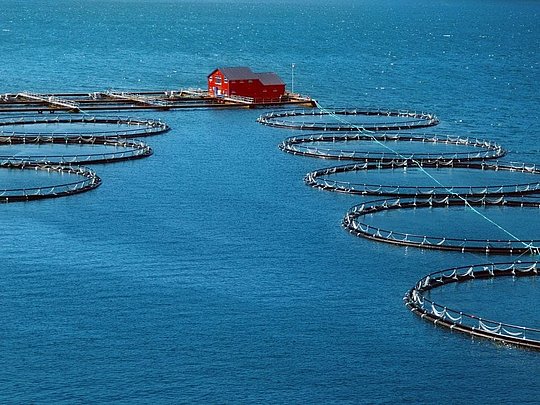Phytogenics in aquaculture production (part 2)
Fish have so many secrets. In part 1 of our mini-series, we have already familiarized ourselves with the basics: the peculiarities of the immune system of fish, as well as the specificities of the right feeding. But what contribution can phytogenics make in aquaculture? Learn more in part 2:
Phytogenics can provide a boost in aquaculture production

Phytogenics in aquaculture provide an opportunity to support the health status of fish. The more intensive fish farming is, the greater the risk of health risks in the stock (Palikova et al., 2014). Reduced performance or even high mortality rates often lead to extensive preventive use of antibiotics. The increasing consumer demand for fish produced without antibiotics, environmentally friendly and animal-friendly aquaculture, however, leads to a change towards sustainable aquaculture production methods. Increasingly large aquaculture facilities and more intensive specialization of the sector are increasingly recognising the benefits of specific phytogenic feed additives in aquaculture and their positive impact on animal performance and health.
In particular, phytogenics adapted to the specific needs of each aquatic species are able to further increase aquaculture production output.
Here are a few facts:

Increase in growth performance:
Growth performance is the most frequently used parameter to determine an adequate production management and it may be affected by different factors, like nutrition, environment, pathogens or handling. Maintaining an optimum growth rate during stressful situations or even promoting it under normal conditions is one of the main demands in the sector. The choice of specific phytogenics, has been demonstrated to promote growth performance and feed efficiency in several fish and shellfish species. For example, Aloe vera (Aloe barbadensis Miller) extract improved growth performance in common carp (Cyprinus carpio) when fed for 8 weeks (Mahdavi et al., 2013). Extracts of garlic (Allium sativum), oregano (Origanum heracleoticum), ginseng, quillaja (Quillaja saponaria), mentha (Mentha piperita) and sweet basil (Ocimum basilicum) promoted growth performance of Nile tilapia (Orechromis niloticus) in several trials (Aly and Mohamed, 2010; Abdel-Latif & Khalil, 2014; Silva et al., 2019; Souza et al., 2019).

Similarly, as shown by Zheng et al. (2009) for channel catfish (Ictalurus punctatus), growth performance and feed efficiency were enhanced when fish were fed with oregano oil and could be associated with a positive effect on the fish microflora composition derived from the well-described antimicrobial properties of oregano. Garlic and onion (Allium cepa) extracts supported growth in European sea bass (Dicentrarchus labrax) (Saleh et al., 2015) and in the case of White-leg shrimp (Litopenaeus vanammei), several phytogenic substances, like yucca (Yucca schidigera), quillaja, ginger (Zingiber officinale), curcuma (Curcuma longa) and astralagus (Astralagus membranaceus) beneficially affected growth performance (Lawhavinit et al., 2011; Yang et al., 2015; Soowannayan et al., 2019; Zhai et al., 2019).
Phytogenics in aquaculture production reveal their benefits not only through improved growth performance: feeding oregano oil also has a positive effect on the composition of fish intestinal microbiota.

Health support:
An optimal immune function of farmed fish and mussels is an important determinant to protect them from infections with pathogens. Several studies have been conducted to determine how phytogenics can strengthen the immune system when fed to farmed fish and shellfish. In this context garlic is the most studied phytogenic in terms of boosting immune system and increasing disease resistance. For example, garlic powder fed to Nile tilapia enhanced fish phagocytic index, bactericidal and lysozyme activities as well as increased disease resistance against Aeromona hydrophyla (Aly et al., 2008). Similarly, rainbow trout (Oncorhynchus mykiss) fed with garlic extract showed enhanced phagocytic activity, respiratory burst and lysozyme activity and consequently, reduced fish mortality when challenged with Aeromona hydrophyla (Nya & Austin, 2009).
Phytogenic ingredients, like oregano, ginger and rosemary (Rosmarinus officinalis) have shown to modulate the immune system of Mozambique tilapia (O. mossambicus) and European sea bass (Dicentrarchus labrax). Moreover, turmeric oil and Gynura bicolor have shown to reduce mortality of white leg shrimp infected with V. harveyi, V. alginolyticus and white spot syndrome virus (WSSV), partially due to their enhancing effects on lysozyme, prophenoloxidase (proPO) and superoxide dismutase (SOD) activity (Vanichkul et al., 2010; Wu et al., 2015).
Did you know?
Some phytogenics have the ability to inhibit quorum sensing. They therefore inhibit the “communication” between bacteria. So these phytogenics can help to inhibit the biofilm formation or production of bacterial toxin, which ultimately reduces or even completely inhibits the frequency of the outbreak of a disease.

Stress reduction:
Stress during aquaculture production is implicated by the production procedure (transport, stocking, grading or sampling) and can be reduced by a proper production management to a minimum. Stress not only leads to reduced feed intake and a lower performance rate, but also increases susceptibility to disease through reduced regulation of the immune system and changes in fish physiology that affect the metabolism of carbohydrates and lipids and other nutrients.
It is important to note that stress is directly related to health or disease resistance, as increased stress on farmed fish and mussels from stress situations can lead to immunosuppression, leading to increased susceptibility to disease.
Studies have shown that feeding phytogenics in aquaculture production such as lemon verbena (Aloysia triphylla), eucalyptus (Eucalyptus sp), Lippia alba, close basil (Ocinum gratissimum) and garlic promotes stress reduction in Nile tile therapies, European sea bass and South American catfish (Rhamidia quelen) by lowering cortisol levels (Montero et al., 2018, Souza et al., 2019).
Further references upon request
You have further questions?

Anne Oberdorf
Anne has always been fascinated by the unknown, the diversity and beauty of nature. Her love for nature brought her to Delacon in 2018 after studying agricultural sciences, where she worked as Technical Communications Manager and later as Product Manager Aquaculture. Since February 2021, she has been taking a new, natural career path outside of Delacon.










